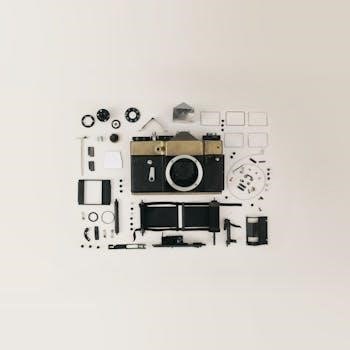ETC Ion Manual⁚ A Comprehensive Guide
Welcome to the comprehensive guide for the ETC Ion lighting control console.
This resource provides users with detailed instructions and information
regarding operation, features, and troubleshooting. The manual is designed
to assist both new and experienced users in effectively utilizing the Ion.
The ETC Ion is a powerful and versatile lighting control console designed for
a wide range of applications, from small venues to complex theatrical
productions. As part of the Eos family, the Ion inherits many of the
advanced features and capabilities found in larger consoles like the Eos Ti,
while offering a more compact and affordable solution. This introduction
provides an overview of the Ion’s purpose and its place within the broader
lighting control landscape.
The Ion is known for its ease of use, powerful features, and operational
style. It delivers the capabilities of larger Eos-family products in a
smaller package. This makes it ideal for venues with limited space or
budgets. The console is designed to provide intuitive control over lighting
fixtures, effects, and cues, allowing users to create stunning visual
displays. Whether you are a seasoned lighting professional or a student
just starting out, the Ion offers a user-friendly interface and a
comprehensive set of tools to bring your creative visions to life.
This manual will serve as a guide through the various aspects of the Ion,
from basic setup and patching to advanced programming and troubleshooting.
With its clear explanations and step-by-step instructions, this manual
will help you master the Ion and unlock its full potential.
ETC Ion⁚ Key Features and Capabilities
The ETC Ion boasts a wide array of features and capabilities that make it a
powerful tool for lighting control. At its core, the Ion offers a
user-friendly interface, combining intuitive hardware controls with a robust
software platform. One of its key strengths lies in its ability to
seamlessly integrate with other Eos family products, allowing for
customizable lighting control systems with remote processors, interfaces,
and backup controllers.
The Ion supports a vast library of lighting fixtures, enabling users to
easily patch and control various types of lights, including conventional,
LED, and moving fixtures. Its advanced cueing system allows for precise
control over timing, intensity, and color, while its effects engine provides
a wide range of dynamic looks. The Ion also offers powerful tools for
creating and managing palettes, allowing users to quickly access and apply
predefined color and beam settings.

Furthermore, the Ion is equipped with features such as Ethernet
connectivity, allowing for remote control and monitoring, as well as
integration with other lighting and media systems. Its software is regularly
updated with new features and improvements, ensuring that users always have
access to the latest technology. These features combine to make the ETC Ion
a versatile and reliable lighting control console for a variety of
applications.
Ion Xe and Ion Xe 20⁚ Overview
The Ion Xe and Ion Xe 20 represent enhanced iterations of the original Ion
lighting control console, offering increased processing power and expanded
feature sets. Both consoles are designed to provide a compact yet powerful
solution for a wide range of lighting applications. The Ion Xe serves as a
versatile option, suitable for smaller venues and touring productions, while
the Ion Xe 20 offers increased capacity for more complex shows.

A key difference between the two models lies in their physical layout and
channel capacity. The Ion Xe 20 features a larger control surface with more
direct access encoders and faders, allowing for quicker and more intuitive
operation. Both consoles, however, maintain the core functionality and
user-friendly interface that the Ion family is known for. They are
compatible with the Eos family software, ensuring seamless integration with
other ETC control systems and accessories.
The Ion Xe and Ion Xe 20 both support advanced features such as pixel
mapping, media server integration, and sophisticated effects processing. They
are designed to handle the demands of modern lighting designs, providing
users with the tools they need to create stunning visual experiences. With
their combination of power, versatility, and ease of use, the Ion Xe and
Ion Xe 20 are excellent choices for lighting professionals seeking a
reliable and feature-rich control solution.
Navigating the ETC Ion Interface
The ETC Ion’s user interface is designed for intuitive and efficient
operation, allowing users to quickly access and control various aspects of
their lighting system. The main display provides a comprehensive overview of
the current show status, including channel levels, cue lists, and system
settings. Softkeys located beneath the display offer context-sensitive
options, providing quick access to commonly used functions.
The command line interface (CIA) is a central element of the Ion’s
navigation. Users can enter commands directly to control channels, record
cues, and perform other actions. The CIA supports a variety of shortcuts and
abbreviations, allowing for faster and more efficient operation. The
console also features dedicated buttons for frequently used functions such as
channel selection, intensity control, and cue playback.
Navigating through the Ion’s various menus and displays is straightforward,
with a clear and logical structure. The patch menu allows users to assign
fixtures to channels and configure addressing. The cue list menu provides
tools for creating, editing, and playing back cues. The setup menu allows
users to customize console settings and configure network connections. With
its well-designed interface and comprehensive feature set, the ETC Ion
empowers users to take full control of their lighting system.
Patching and Addressing Fixtures on ETC Ion
Patching and addressing fixtures is a fundamental step in setting up your
lighting system on the ETC Ion console. This process involves assigning
each physical lighting fixture to a specific channel number within the
console’s memory, and configuring the fixture’s DMX address so that the
console can communicate with it.
To begin patching, access the Patch menu on the Ion console. Here, you can
add new fixtures by selecting their manufacturer and model from the console’s
extensive library. The console will then prompt you to enter the desired
channel number and DMX address for the fixture. It is crucial to ensure that
each fixture has a unique DMX address to avoid conflicts.
The Ion console offers several tools to simplify the patching process. You
can use the “Auto Patch” feature to automatically assign channel numbers and
DMX addresses to multiple fixtures based on a defined pattern. The console
also allows you to create custom fixture profiles if your specific fixture
is not included in the library. By carefully patching and addressing your
fixtures, you can ensure that your lighting system is properly configured
and ready for programming.
Cueing and Playback on ETC Ion
Cueing and playback are central to operating the ETC Ion console, allowing
users to create and execute complex lighting sequences. A cue is a snapshot
of the lighting state at a particular moment, storing information about
intensity levels, colors, and other parameters for each fixture. These
cues are then arranged in a sequential order to form a cue list, which can
be played back in a variety of ways.
To create a cue, first, set the desired lighting levels and colors using the
console’s controls. Then, press the “Record” button and assign the cue to a
specific cue number in the cue list. You can also add notes to each cue to
describe its purpose or content.

The Ion console provides several playback options, including manual playback
using the console’s faders and buttons, as well as automated playback
using the console’s built-in timer. You can also link cues together using
links and loops to create repeating sequences. Mastering cueing and
playback techniques will allow you to design and execute sophisticated
lighting designs with ease.
Using Effects and Palettes with ETC Ion
The ETC Ion console offers powerful tools for creating dynamic and visually
interesting lighting designs through the use of effects and palettes.
Effects are pre-programmed or user-defined sequences that automate changes
in lighting parameters, such as intensity, color, or position. Palettes,
on the other hand, are stored values for specific attributes, like color,
beam, or focus, that can be quickly recalled and applied to fixtures.
To use effects, you can select from a library of built-in effects or create
your own custom effects using the console’s effect editor. These effects
can then be applied to selected fixtures and modified to suit the specific
needs of your design.
Palettes allow you to store and recall frequently used color combinations,
beam angles, or focus positions. This can save time and ensure consistency
across your lighting design. The Ion console allows you to create and
manage a wide range of palettes, making it easy to access your favorite
looks and apply them to different fixtures. By combining effects and
palettes, you can create dynamic and engaging lighting designs with
precision.
ETC Ion Software Updates and Downloads
Keeping your ETC Ion console up-to-date with the latest software is crucial
for optimal performance, access to new features, and bug fixes. ETC
regularly releases software updates for the Ion console, which can be
downloaded from the ETC website. These updates often include improvements
to the console’s functionality, enhanced compatibility with other devices,
and resolutions to known issues.
To download the latest software for your ETC Ion console, visit the
downloads section of the ETC website. Make sure to select the correct
version of the software for your specific Ion model. Before installing the
update, it’s recommended to back up your console’s data, including show
files and settings, to prevent data loss.
The ETC website also provides access to various other downloads related to
the Ion console, such as documentation, manuals, and sample show files.
These resources can be helpful for learning more about the console’s
features and capabilities. Regularly checking for software updates and
exploring the available downloads will ensure that you’re getting the most
out of your ETC Ion console.
Troubleshooting Common Issues on ETC Ion
Even with careful operation, occasional issues may arise while using the
ETC Ion lighting console. This section provides guidance on troubleshooting
some common problems. If you encounter unexpected behavior, begin by
checking the console’s display for error messages, which often provide
valuable clues about the nature of the problem.
One common issue is patching errors, which can prevent fixtures from
responding correctly. Verify that the fixture addresses and patch
information are accurate. Network connectivity problems can also disrupt
communication between the console and other devices. Check the network
settings and connections to ensure they are properly configured.
If you experience playback issues, such as cues not firing or fading
incorrectly, examine the cue list settings and timing parameters. Problems
with effects and palettes may indicate errors in their configuration or
compatibility issues with certain fixtures. Restarting the console can
sometimes resolve temporary glitches. Consult the ETC Ion manual and online
resources for more in-depth troubleshooting guidance. If the problem
persists, contacting ETC technical support is recommended.
ETC Eos Family Integration with Ion
The ETC Ion lighting control console is a part of the broader ETC Eos
family, which includes consoles like Eos Ti, Gio, and Element. This
integration allows for seamless interaction and data sharing between
different consoles within the Eos ecosystem. Understanding how Ion
interacts with other Eos family members can significantly enhance your
lighting control capabilities.
One key benefit of this integration is the ability to transfer show files
between consoles. This is particularly useful in environments where
multiple consoles are used for different purposes, such as programming on
a larger console like Eos Ti and then executing the show on the more
compact Ion. The Eos family also supports remote processors and interfaces,
allowing for extended control and monitoring capabilities.

Furthermore, the Eos family shares a common software platform, ensuring
consistency in features and workflows across different consoles. This
familiarity reduces the learning curve when transitioning between consoles
and simplifies collaboration among lighting professionals. The integration
also extends to backup solutions, where one Eos console can serve as a
backup for another, ensuring uninterrupted operation during live events.
